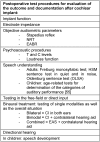Cochlear implant - state of the art
- PMID: 29503669
- PMCID: PMC5818683
- DOI: 10.3205/cto000143
Cochlear implant - state of the art
Abstract
Cochlear implants are the treatment of choice for auditory rehabilitation of patients with sensory deafness. They restore the missing function of inner hair cells by transforming the acoustic signal into electrical stimuli for activation of auditory nerve fibers. Due to the very fast technology development, cochlear implants provide open-set speech understanding in the majority of patients including the use of the telephone. Children can achieve a near to normal speech and language development provided their deafness is detected early after onset and implantation is performed quickly thereafter. The diagnostic procedure as well as the surgical technique have been standardized and can be adapted to the individual anatomical and physiological needs both in children and adults. Special cases such as cochlear obliteration might require special measures and re-implantation, which can be done in most cases in a straight forward way. Technology upgrades count for better performance. Future developments will focus on better electrode-nerve interfaces by improving electrode technology. An increased number of electrical contacts as well as the biological treatment with regeneration of the dendrites growing onto the electrode will increase the number of electrical channels. This will give room for improved speech coding strategies in order to create the bionic ear, i.e. to restore the process of natural hearing by means of technology. The robot-assisted surgery will allow for high precision surgery and reliable hearing preservation. Biological therapies will support the bionic ear. Methods are bio-hybrid electrodes, which are coded by stem cells transplanted into the inner ear to enhance auto-production of neurotrophins. Local drug delivery will focus on suppression of trauma reaction and local regeneration. Gene therapy by nanoparticles will hopefully lead to the preservation of residual hearing in patients being affected by genetic hearing loss. Overall the cochlear implant is a very powerful tool to rehabilitate patients with sensory deafness. More than 1 million of candidates in Germany today could benefit from this high technology auditory implant. Only 50,000 are implanted so far. In the future, the procedure can be done under local anesthesia, will be minimally invasive and straight forward. Hearing preservation will be routine.
Keywords: cochlear implant; complications; diagnostics; future developments; results; sensory deafness; surgical procedure.
Conflict of interest statement
The author declares that he has no competing interests.
Figures



















































Similar articles
-
[Cochlear Implant - State of the Art].Laryngorhinootologie. 2017 Apr;96(S 01):S123-S151. doi: 10.1055/s-0043-101812. Epub 2017 May 12. Laryngorhinootologie. 2017. PMID: 28499298 Review. German.
-
Cochlear Implantation: Concept, Results Outcomes and Quality of Life.Laryngorhinootologie. 2022 May;101(S 01):S36-S78. doi: 10.1055/a-1731-9321. Epub 2022 May 23. Laryngorhinootologie. 2022. PMID: 35605612 English, German.
-
Auditory Performance and Electrical Stimulation Measures in Cochlear Implant Recipients With Auditory Neuropathy Compared With Severe to Profound Sensorineural Hearing Loss.Ear Hear. 2017 Mar/Apr;38(2):184-193. doi: 10.1097/AUD.0000000000000384. Ear Hear. 2017. PMID: 28225734
-
Trimodal speech perception: how residual acoustic hearing supplements cochlear-implant consonant recognition in the presence of visual cues.Ear Hear. 2015 May-Jun;36(3):e99-112. doi: 10.1097/AUD.0000000000000131. Ear Hear. 2015. PMID: 25514796
-
Cochlear implants: selection criteria and shifting borders.Acta Otorhinolaryngol Belg. 1998;52(3):183-99. Acta Otorhinolaryngol Belg. 1998. PMID: 9810453 Review.
Cited by
-
The evaluation of a surgery and the short-term benefits of a new active bone conduction hearing implant - the Osia®.Braz J Otorhinolaryngol. 2022 May-Jun;88(3):289-295. doi: 10.1016/j.bjorl.2020.05.021. Epub 2020 Jul 4. Braz J Otorhinolaryngol. 2022. PMID: 32713797 Free PMC article. Clinical Trial.
-
Developing Fast, Red-Light Optogenetic Stimulation of Spiral Ganglion Neurons for Future Optical Cochlear Implants.Front Mol Neurosci. 2021 Mar 11;14:635897. doi: 10.3389/fnmol.2021.635897. eCollection 2021. Front Mol Neurosci. 2021. PMID: 33776648 Free PMC article.
-
Hydraulic insertions of cochlear implant electrode arrays into the human cadaver cochlea: preliminary findings.Eur Arch Otorhinolaryngol. 2022 Jun;279(6):2827-2835. doi: 10.1007/s00405-021-06979-z. Epub 2021 Aug 14. Eur Arch Otorhinolaryngol. 2022. PMID: 34390390 Free PMC article.
-
Improved optogenetic modification of spiral ganglion neurons for future optical cochlear implants.Theranostics. 2025 Mar 18;15(10):4270-4286. doi: 10.7150/thno.104474. eCollection 2025. Theranostics. 2025. PMID: 40225583 Free PMC article.
-
Nonverbal synchrony in subjects with hearing impairment and their significant others.Front Psychol. 2022 Aug 18;13:964547. doi: 10.3389/fpsyg.2022.964547. eCollection 2022. Front Psychol. 2022. PMID: 36059730 Free PMC article.
References
-
- Deutsche Gesellschaft für Hals-Nasen-Ohren-Heilkunde, Kopf- und Hals-Chirurgie. Leitlinie Cochlea-Implantat Versorgung einschließlich zentral-auditorischer Implantate 05/2012. AWMF Register-Nr. 017–071. Available from: http://www.awmf.org/leitlinien/detail/ll/017-071.html.
-
- Djourno A, Eyries C, Vallancien P. Premiers essais d'excitation électrique du nerf auditif chez l'homme, par micro-appareils inclus à demeure. [Preliminary attempts of electrical excitation of the auditory nerve in man, by permanently inserted micro-apparatus]. Bull Acad Natl Med. 1957;141(21-23):481–483. (Fre). - PubMed
-
- Zöllner F, Keidel WD. Gehörvermittlung durch elektrische Erregung des Nervus acusticus. [Transmission of hearing by electrical stimulation of the acoustic nerve]. Arch Ohren Nasen Kehlkopfheilkd. 1963;181:216–223. doi: 10.1007/BF02103758. (Ger). Available from: http://dx.doi.org/10.1007/BF02103758. - DOI - DOI - PubMed
-
- Lehnhardt E. Cochlea-Implantate. In: Lenarz T, editor. Cochlea-Implantate. Heidelberg: Springer; 1998.
-
- Zwicker E, Leysieffer H, Dinter K. Ein Implantat zur Reizung des Nervus acusticus mit zwölf Kanälen. [An implant for stimulation of the acoustic nerve with 12 channels]. Laryngol Rhinol Otol (Stuttg) 1986 Mar;65(3):109–113. doi: 10.1055/s-2007-998795. (Ger). Available from: http://dx.doi.org/10.1055/s-2007-998795. - DOI - DOI - PubMed
Publication types
LinkOut - more resources
Full Text Sources
Other Literature Sources
Molecular Biology Databases

